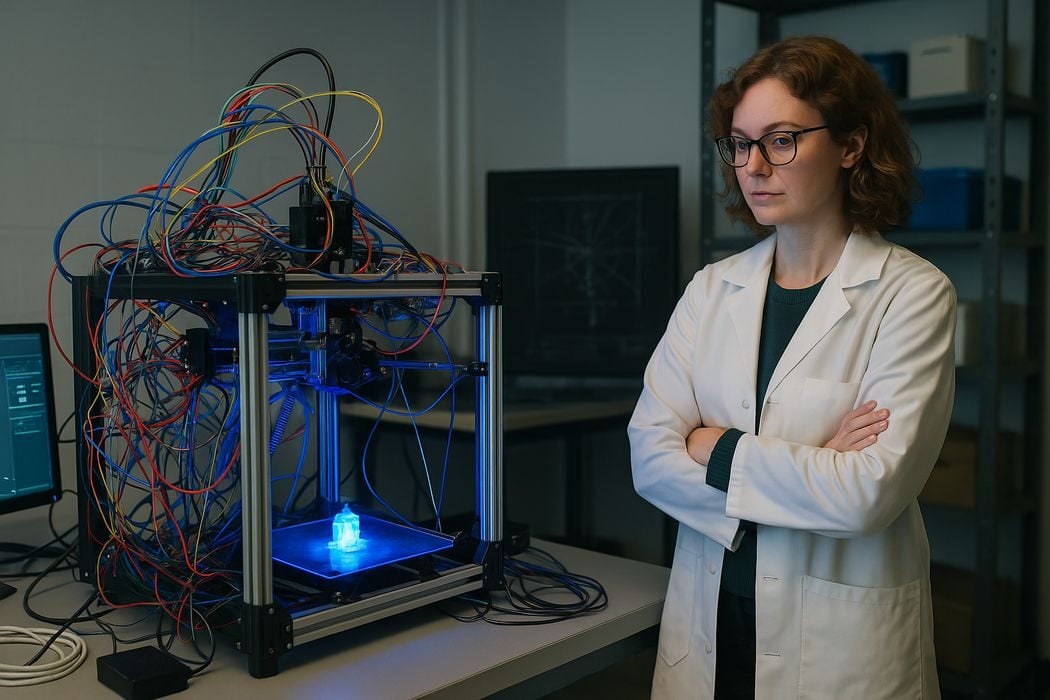
Just when you thought 3D printing had reached its limits, researchers are now reaching into unseen realms — literally.
A new experimental initiative at the University of Western Oslo’s Advanced Geometry Lab is exploring what may be the next frontier in additive manufacturing: 5D 3D printing, based on the hidden spatial dimensions predicted by string theory.
For decades, physicists have theorized that our universe might contain more than the familiar three spatial dimensions (length, width, height) and one temporal dimension (time). In particular, M-theory, a branch of string theory, proposes that the universe is composed of 11 dimensions, most of which are compactified or “curled up” at scales far beyond human perception.
Now, Dr. Leona Thatch, a theoretical physicist with a background in complex geometry and digital fabrication, is attempting to print into those dimensions.
“Our tools are still anchored in 3D space,” Dr. Thatch explained. “But if these higher dimensions affect reality — even subtly — then perhaps we can design objects that take advantage of them. What we’re attempting is not just 3D printing with time as a factor, but printing into the hidden fabric of the universe.”

At the heart of her project is a modified CoreXY printer dubbed the Kaluza, named after Theodor Kaluza, one of the first scientists to propose extra dimensions as part of physical law. The Kaluza printer includes several exotic modifications:
- A quaternion-based kinematic system that allows for motion interpolation beyond standard Cartesian limits;
- A custom slicer built on Calabi–Yau topology, enabling the encoding of extra-dimensional instructions in G-code;
- And a prototype “brane modulator,” which attempts to orient the print plane with respect to higher-dimensional manifolds using magnetic interference and a rotating gyroscopic array.
“From our perspective, the printed object appears mostly normal,” Thatch said. “But we believe these objects have nonlocal properties. One prototype vanished when no one was observing it. Another seemed to weigh slightly more than it should, but only at odd intervals.”

Early experiments have yielded objects the team calls “dimensionally extended artifacts”, which resist standard analysis. Among them:
- A Möbius strip with no measurable surface tension
- A cube that casts shadows inconsistent with the lab’s lighting
- And a 3D Benchy that appears normal, but when placed on water, somehow floats sideways
While the project remains speculative, the implications are vast. “If we can encode data into compactified dimensions,” Thatch explained, “we may be able to build objects with properties that transcend classical material limitations — strength, heat resistance, even causality.”
Potential applications include:
- Temporal-stable memory structures that don’t degrade over time
- Quantum-keyed containers that only open when observed correctly
- And higher-order support structures that exist only during printing, then phase out
Skeptics remain unconvinced. “They’re generating G-code that can’t be visualized and claiming it prints into dimensions we can’t see,” said one critic. “That’s not innovation — that’s a philosophy degree with stepper motors.”
Still, Dr. Thatch’s team is pressing forward. A preprint of their work, titled “Towards Tangible Calabi–Yau Embeddings in Consumer-Grade FFF Systems”, has already sparked interest — and confusion — across the additive and theoretical physics communities.
For those hoping to try it at home, the Kaluza printer is not yet commercially available, though schematics have been released under a Nonlinear Reciprocal Attribution License (NRAL), which paradoxically requires future citations to precede actual use.
As for commercialization, Dr. Thatch offers a cryptic suggestion: “We’ve already shipped the first units. You just haven’t received them yet.”
And as for the endgame? Dr. Thatch offers only a smile.
“If we can print in five dimensions, who says we can’t go to eleven?”
Via Dimensional Mechanics Today
